Navigating the Landscape of 3D Car Rendering Techniques
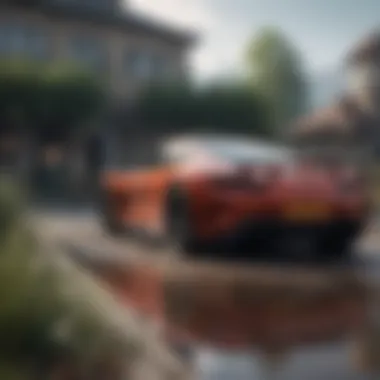
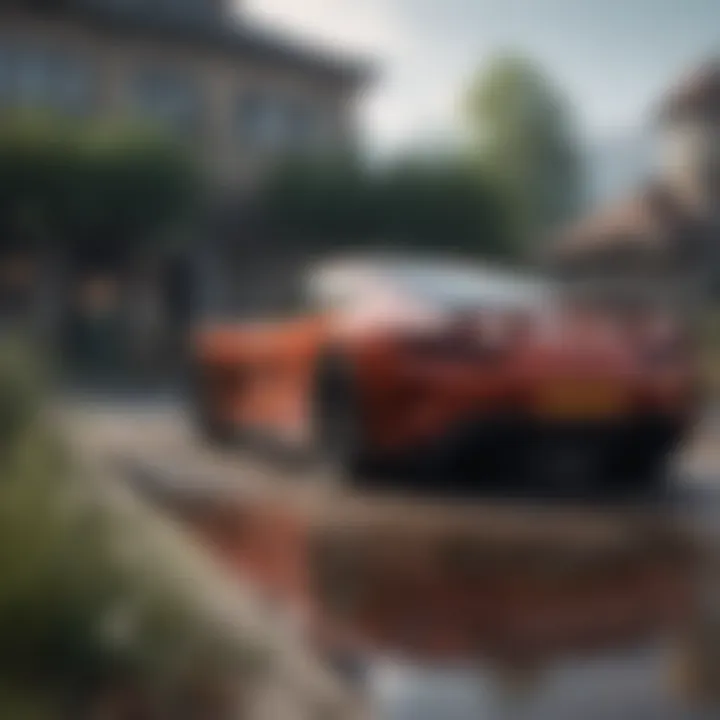
Intro
3D rendering in the automotive sector stands as a compelling intersection of art, science, and technology. The ability to create photorealistic images of cars revolutionizes how manufacturers and consumers interact with vehicles before they ever physically exist. The integration of sophisticated rendering techniques not only facilitates better design workflows but also transforms marketing strategies and consumer perceptions.
As we delve into this extensive field, it becomes evident that 3D rendering encompasses both advanced software tools and a variety of artistic skills. From initial conceptualization to stunning final visuals, this process allows designers to explore innovative ideas rapidly. Also, it engages potential buyers realistically, presenting them with clear-cut representations of vehicles.
Understanding the roles of various rendering technologies, formats, and artistic techniques is essential for professionals in automotive design, marketing, or engineering. This narrative aims to provide intricate insights into the tools utilized, prevalent challenges faced, and promising future trends contemplated by experts in this discipline.
Product Overview
In the automotive industry, the relevance of 3D rendering cannot be overstated. It crucially works to merge imagination with reality, producing exceptionally detailed representations of vehicles during different production phases.
Intro to 3D Rendering in Automotive
The key technologies that underpin 3D rendering are software solutions like Blender, Autodesk 3ds Max, and KeyShot. Each program carries unique capabilities that cater to the varied aspects of the rendering process. For example, KeyShot is recognized for its strength in applying realistic materials and lighting effects effortlessly.
Key Features and Specifications
- Photorealistic Outputs: The essence of advanced rendering rests in its ability to generate images that closely mimic actual photographs.
- Real-time Visual Effects: Sophisticated rendering engines produce visuals that can be updated instantly. This functionality contributes to rapid design iterations.
- Adaptability and Integration: Many rendering packages seamlessly incorporate plugins that facilitate extra features, aligning with other design tools for efficiency outputs.
Design and Aesthetics
3D rendering serves as an artistic platform as much as it is a technical one. The richness of visual detail enhances the aesthetic allure of conceptualized automobile designs. This aspect is not merely about function; aesthetics play a paramount role in attracting set criteria of buyers.
Rendering also helps automotive designers visualize concepts that challenge contemporary boundaries, ultimately pushing the industry towards innovative design solutions.
Prolusion to 3D Rendering
3D rendering has revolutionized various industries, particularly automotive design. Understanding 3D rendering is key to appreciating its role in product development, marketing, and consumer engagement in the modern automotive landscape. Designers, marketers, and engineers now rely heavily on these visual representations to articulate ideas and concepts that once required elaborate physical prototypes.
Rendering allows for the visualization of both aesthetic and functional aspects of automobiles. It fosters innovations in design while simplifying the communication between teams. Moreover, the creation of hyper-realistic images can significantly enhance promotional strategies. As we delve deeper into this subject, we will explore its basic definition and the historical development, highlighting its growing importance in today’s market.
Definition and Overview
3D rendering is the process of creating a two-dimensional image or animation from a three-dimensional model through computer software. It involves simulating how light interacts with objects to generate realistic visuals and captures surfaces, textures, and intricate details of an object—a car in this scenario. This advancement allows designers not only to represent their concepts visually but also to iterate on modifications effectively.
Rendering techniques can be classified broadly into two categories: offline and real-time. Offline rendering is computationally intensive and is preferred for film and detailed presentations. In contrast, real-time rendering is crucial for interactive applications like video games or VR experiences.
In automotive design, 3D rendering provides insights into form and function. It allows companies to explore various design iterations without a substantial investment in resources. It minimizes much of the preliminary design work traditionally performed using sketches or physical models, thus accelerating the development cycle.
Historical Context
The journey of 3D rendering has its beginnings in the late 1960s and early 1970s with the pioneering visual computing endeavors. Initially utilized in military and industrial settings, these technologies found their way into entertainment and, eventually, product design. Over the decades, advancements in computational power and graphics algorithms laid the groundwork for rendering applications we see today.
The 1980s saw significant contributions from academic circles, which led to the creation of seminal rendering software. As personal and workstation computing capabilities expanded, so did the applications of rendering in design. The rise of sophisticated software programs like Autodesk’s 3ds Max or Blender generated unprecedented opportunities in the car design process.
Notably, by the 1990s and into the 2000s, 3D rendering became a cornerstone of automotive marketing. It allowed car manufacturers not only to design but visualize marketing materials before the physical car exists. With the advent of digital platforms, car companies could engage consumers in ways never seen before, using rendered imagery to showcase their vehicles under various environmental conditions, achieving remarkable realism.
By integrating advancements in AI and rendering technology, the future holds great promise for further transforming the rendering landscape in automotive design, thereby enhancing experiences at each consumer touchpoint.
Significance of 3D Rendering in Automotive Design
3D rendering has become a cornerstone in automotive design, playing a vital role in how vehicles are conceived, developed, and marketed. The integration of this technology in the industry not only enhances the aesthetic appeal of the cars but also streamlines various processes from design to marketing. Realistic representations through rendering facilitate better communication ideas between designers and stakeholders.
Role in Design Development
In automotive design, the role of 3D rendering cannot be understated. Designers leverage precise visualization tools to iterate and evaluate their ideas effectively. With advanced software, they can create detailed models that represent every component of the vehicle. This capability allows for modifications to be made early in the design phase, significantly reducing costly revisions later.
The process also encompasses:
Ideation: Designers can propose multiple versions of a car in a simulated environment, analyzing different styles and functionalities quickly. Collaboration: The rendered images make it easier to share concepts with teams and clients who are not adept at technical sketches. Feedback: Gaining input from various stakeholders becomes smooth when they can see lifelike images compared to basic drawings.
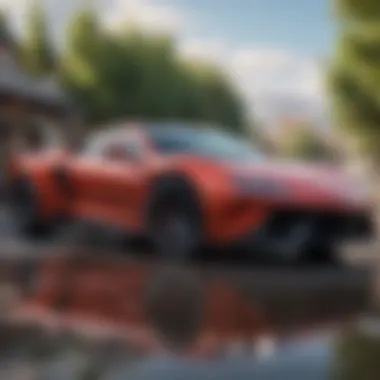

Thus, designers can foster a creative atmosphere by harnessing technology that offers exact visual feedback throughout the product's lifespan.
Impact on Marketing Strategies
Beyond design development, 3D rendering recalibrates marketing strategies for automotive companies. The ability to generate high-quality visuals influences how brands promote their vehicles across multiple platforms.
Key marketing applications include:
Advertising Campaigns: Stunning imagery created through rendering can be utilized across print, online, and TV ads to grab consumers' attention. Virtual Showrooms: Many brands now create virtual showrooms that allow potential customers an interactive space in which to explore vehicle features. Product Launches: When presenting new models, 3D-rendered visuals provide compelling narratives that help to convey the innovation of designs.
In short, 3D rendering has fortified marketing efforts so that car manufacturers can deliver an engaging experience to their target audience, often resulting in increased sales and a stronger market presence.
The significance of 3D rendering in automotive design is evident in its profound effect on both the creative and promotional landscapes of car production.
3D rendering equips automotive designers and marketers with the tools needed to visualize precision, enhance collaboration, and boost consumer engagement.
Tools and Software for 3D Rendering Cars
Tools and software play a critical role in the realm of 3D rendering for cars. They determine the quality of the visual output, including realism and detail. Various programs are developed with unique strengths, targeting specific needs in design and visualization processes. It is essential to explore which tools are optimal for different stages of car rendering, considering factors like performance, usability, and incorporate functionalities.
Popular Software Solutions
Blender
Blender is an open-source 3D creation suite that has gained popularity due to its comprehensive features. It contributes significantly to automotive design, allowing designers to model, texture, and render cars effectively. One key characteristic of Blender is its flexibility – it accommodates various workflows, making it attractive to both amateurs and professionals.
A unique feature of Blender is its adaptability through community-creating plugins. This can enhance rendering capabilities or introduce new tools for users. A notable advantage of Blender is its zero cost, lowering the entry barrier for many users. Citation should be made to environments already utilizing this tool with tangible outcomes among startups.
Autodesk 3ds Max
Autodesk 3ds Max specializes in high-level models and stunning visual effects, making it ideal in the automotive sector. It offers vast graphical capabilities that allow for intricate details in car designs. The key characteristic that stands out is its robust rendering options, which include Arnold, a powerful integrated renderer.
3ds Max provides highly customizable interfaces, granting users more control over each aspect of their design. However, the software does come with its disadvantages, including a steeper price tag and significant resource consumption on computers, making system specifications essential for optimal performance.
Cinema 4D
Cinema 4D brings a particular skill set advantageous to animation and motion graphics within automotive rendering. It is known for its intuitive user interface, allowing designers to create stunning visuals without extensive training. Its key characteristic is offering rapid prototyping abilities, making it functionally beneficial for quick iterations and adjustments.
This software particularly shines in integration with Adobe products, proving critical for many designers already embedded in Adobe's ecosystem. Yet, Cinema 4D may not cover all advanced features found in more specialized programs and might lead users to seek additional tools for highly technical rendering specifics.
Emerging Technologies
Real-Time Rendering
Real-time rendering has revolutionized how cars are visualized by enabling immediate feedback in design processes. It is essential for testing aesthetics in real-time simulations which often aids rapid conceptualization. This technology allows designers to make instant adjustments, improving efficiency.
A critical characteristic of real-time rendering is its ability to display changes live. This greatly enhances collaboration between design teams, as everyone can see updates immediately. However, real-time rendering involves rigorous hardware demands, making investment in superior rigs often necessary for practical use.
AI in Rendering
AI in rendering is increasingly relevant to the automotive design process. By optimizing workflows through learning models, AI can significantly reduce rendering time, enabling quicker project turnarounds. Its key characteristics encompass procedural generation, which automates yet retains design creativity enabling teams to focus on more critical aspects of projects.
AI promises distinct advantages, such as improved resource allocation and the capability to handle massive data. Yet, it’s important to acknowledge potential downsides, such as dependency on training data and the occasional uninspired creativity due to machine processing merely imitating styles rather than innovating.
Effective utilization of these tools not only enhances visual output but propels innovation within the automotive design field, ensuring relevance in fast-evolving market.
The 3D Rendering Process
The 3D rendering process is a crucial component in the automotive industry. It encompasses various stages that contribute to creating lifelike visualizations of vehicle designs. These stages make sure that initial concepts evolve into finished visuals suitable for design, marketing, and consumer engagement. A clear understanding of this process is important for professionals in technology and automotive sectors.
Initial Conceptualization
This first phase involves the generation of core ideas and design sketches. Initial concept sketches serve as the foundation for digital work. Designers gather inspiration from numerous sources including market trends and customer preferences. Tools like Autodesk Sketchbook can aid this transitional task, allowing for fast sketching and iteration.
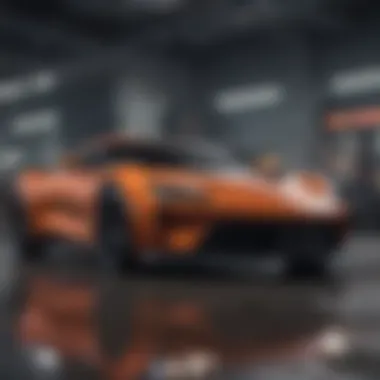
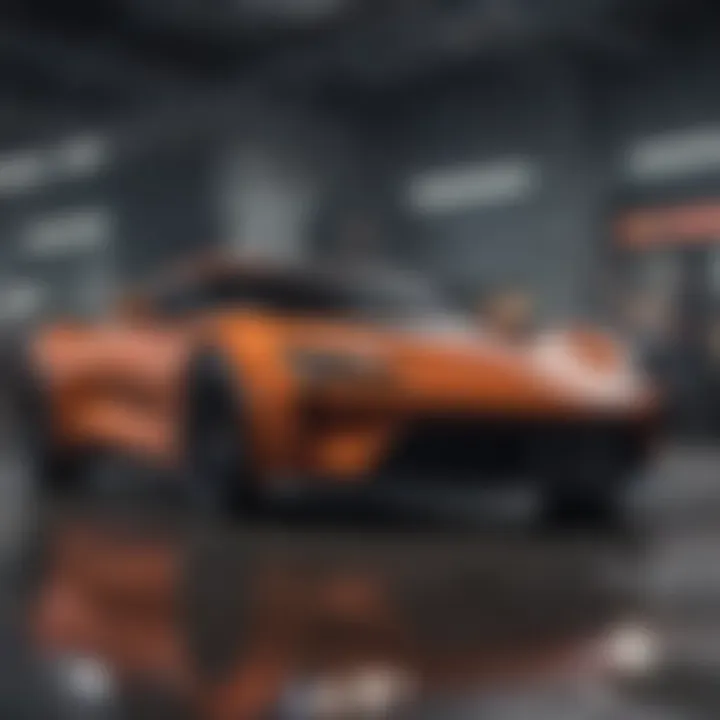
During this stage, it is vital to weigh aesthetics against functionality. What looks appealing on paper must also align with automotive engineering constraints. This back-and-forth thinking develops ideas thoroughly. The intention is to provide a firm direction before diving deeper into software modeling. It saves time later by reducing revision rounds in the modeling phase.
Model Creation
Once conceptual sketches receive approval, the next step is the 3D model creation. Here, industry-standard systems like Blender or Autodesk 3ds Max come into play. These software solutions provide extensive high-polygon modeling capabilities. Experts start constructing digital 3D representations of sketches, paying special attention to every detail.
Effective communication among the project team is essential during this phase. Design adjustments often require swift responses. The engineering side provides input to insert practical elements in the model. Moreover, low-polygon models are usually crafted first to iterate the shapes quickly. Optimization allows faster rendering without compromising quality.
Texturing and Lighting
Texturing and lighting add realism to the model. This portion of rendering involves applying surfaces and details to the model that mimic materials found in real life. Real-world behaviors also dictate how materials should react to light. For example, gloss on metal or softness in fabric.
To promote detail authenticity, textures must reflect imperfections and nuances. Software like Substance Painter can enhance textures, enabling high-definition results.
Lighting adjusts the atmosphere within an environment, which can significantly change moods and perceptions of design. Techniques like three-point lighting create depth, helping to display the model’s features effectively. Well-structured layers promote a dimensional look. Thus, engaging lighting configurations are beneficial.
Rendering Techniques
The rendering techniques definition is often tied to the artistry behind computer-generation processes. Techniques diversify, ensuring optimal visual outcomes. Some common methods include ray tracing, rasterization, and global illumination. Each method caters to various ends of the personality within a project and can holistically establish an artistic vision.
Ray tracing stands out for creating realistic acoustics and shadow interactions, often at high GPU costs. Rasterization provides faster results and suits commercial pieces, where speed might trump superfluous detail. Global Illumination combines both, capturing realism using a balanced approach.
Advanced software suites are comparable to cameras already taken for granted. The understanding of rendering settings negatively or positively alters finalized images. Experimentation with contrast, tone, and shadows informs how powerfully a design engages the viewer. Proficiency with these techniques is vital in recognizing limitations and tapping into potentials aligned with overall project scopes.
"Until the right blend of creativity and technology is achieved, visual outputs won’t transcend just looking good."
Achieving specificity ensures that every iteration throughout the 3D rendering process builds toward captivating reality. Each step is interlinked, progressively edifying the overall quality of results produced. Understanding these nuances can elevate clarity and commit authenticity in 3D automotive visualizations.
This rendering journey will set the stage for multiple applications across automotive industries in the long-term future. By knowing these fundamental processes, professionals can cultivate impactful results in their respective automotive spheres.
Applications of 3D Rendering in the Automotive Sector
The automotive sector increasingly relies on 3D rendering to address a variety of needs and challenges in car design and marketing. Its applications are vast, extending from the crucial early stages of development to consumer-facing promotional efforts. Understanding these applications can provide valuable insights into the intricate processes that define modern automotive manufacturing.
Prototyping and Design Validation
The prototyping phase is where various ideas take form. In this context, 3D rendering plays a pivotal role. Designers can create highly detailed digital renderings of their concepts. These visualizations allow for immediate feedback on the design elements. In traditional methods, shifts in design often require physical prototypes, which are time-consuming and costly.
Using software like Autodesk 3ds Max and Blender, teams can produce virtual models efficiently. 3D rendering software provides tools to modify designs quickly. This leads to better time management and cost-effectiveness. Once a model is rendered, designers can present it to stakeholders or focus groups for validation. The iterative nature of rendering enables technologists and designers to refine their ideas, ensuring that flawed assumptions are corrected before manufacturing takes place.
Consequently, 3D rendering contributes significantly to enhancing the quality of the final product by streamlining the design validation process.
Advertising and Marketing
3D rendering has transformed how car manufacturers approach marketing. With stunning visuals and realistic product displays, manufacturers can convey a better understanding of their vehicles. Detailed renderings help customers appreciate features that may not be easily accessible in traditional models.
In advertisements, whether online or in print, vivid imagery is crucial. The use of renderings allows for high-quality images that can be manipulated professionally. They can project the vehicle in various environments, appealing to certain demographics. Rendered imagery can showcase the car in urban settings, highlight premium interior options, or focus on advanced technology features. Thus, companies can personalize their marketing strategies effectively.
The potential for virtual showroom experiences also makes 3D rendering invaluable. Brands utilize it to design interactive online platforms where consumers can virtually examine vehicles. This approach not only engages buyers but aligns with current trends shifting towards more digital consumer experiences.
Virtual Reality Experiences
The rise of virtual reality (VR) further exemplifies the practical applications of 3D rendering in automotive design. VR experiences offer immersive perspectives otherwise unattainable with standard outputs. Customers can virtually
Trends Influencing 3D Car Rendering
The topic of trends influencing 3D car rendering is crucial in understanding the evolution and future direction of automotive design. The advancements in technology continually modify how designers visualize and create vehicles. This section examines significant trends, focusing mainly on sustainability considerations and the integration of artificial intelligence and machine learning.
Sustainability Considerations
Sustainability has become a focal point in many industries, and 3D rendering in automotive is no exception. As environmental concerns grow, designers seek ways to reduce waste while improving efficiency. Using 3D rendering can actually minimize the physical resources needed during the design process. Instead of creating numerous physical prototypes, manufacturers can produce virtual ones, eliminating material waste and lowering carbon footprints.
3D rendering allows for accurate simulations of designs at various stages. This enhances understanding of how a vehicle will perform, optimizing aerodynamic efficiency and structural integrity before any materials are actually cut. A virtual prototype ensures design tweaks can occur without incurring costly modifications during physical assembly.
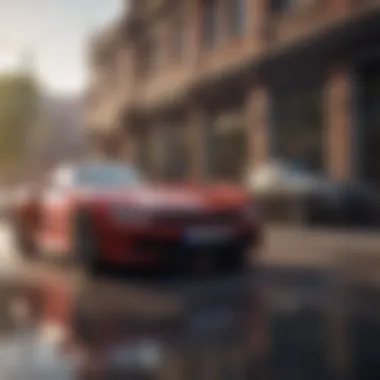
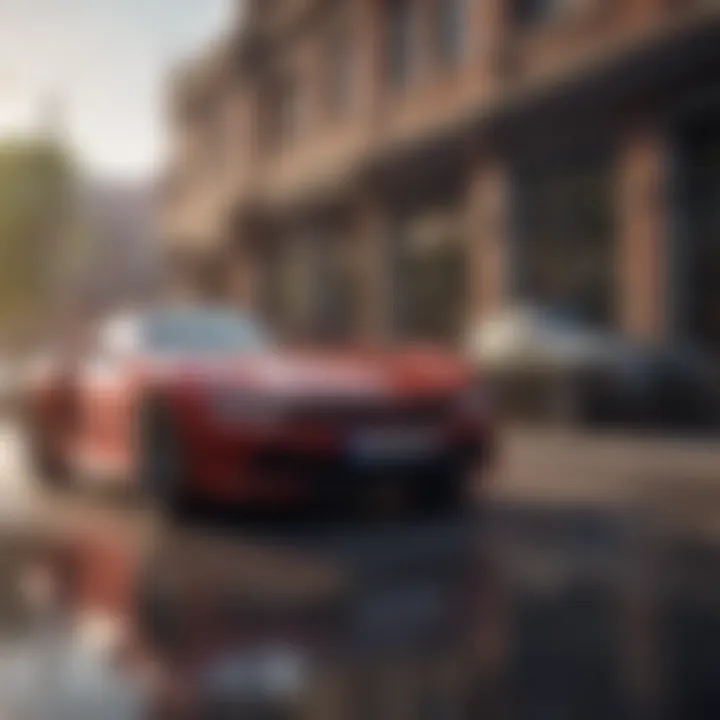
- Benefits of sustainability in 3D car rendering include:
- Reduction in Waste: Less need for physical prototypes.
- Cost Efficiency: Lowers development costs over time.
- Enhanced Design Flexibility: Adjustments can be made quickly before any final production.
Thus, an emphasis on sustainable methods helps align the automotive industry with broader environmental goals while advancing 3D rendering as a preferable protocol for modern design development.
Integration of AI and Machine Learning
The integration of artificial intelligence and machine learning into 3D car rendering transforms how automotive manufacturers approach design and production. AI algorithms can analyze vast amounts of data, aiding designers in making informed decisions much faster. The trend towards using AI allows for the analysis of aesthetics, performance standards, and consumer preferences, fundamentally changing design processes.
One significant application of AI in 3D rendering is generative design, where algorithms creatively propose design options by simulating various configurations based on set parameters. This not only speeds up the creative process but also inspires innovation in design that might not be apparent through traditional methods.
Furthermore, machine learning can help improve the rendering process itself. Techniques like enhanced photorealism can be achieved through AI’s ability to learn patterns and predict outcomes based on previous projects. As AI technology develops, it paves the way for even faster and more efficient rendering processes, benefiting practical applications like virtual reality car showrooms where customers can include detailed options while saving manufacturers time.
As AI continues to evolve, its role in 3D rendering not only enhances design but optimally informs about market trends and preferences.
With the constantly evolving terrain of technology, the integration of AI and machine learning holds vast potential for future innovations. Effectively, automotive designers can rechannel focus on creativity, innovation, and strategic problem-solving in this rapidly changing landscape.
Challenges in 3D Rendering for Cars
In the landscape of automotive design, 3D rendering is not an idyllic process; numerous challenges resist the seamless integration of this innovative technology. As vehicles become more complex and demanding of precision, understanding the hurdles within 3D rendering can greatly influence design efficiency, project timelines, and, ultimately, the overall outcome. Amidst the rapidly shifting technological ecosystem, addressing these challenges becomes not only beneficial but crucial.
Technical Limitations
Technical limitations frequently serve as a barrier to achieving optimal results in 3D rendering. This includes constraints related to software capabilities, hardware performance, and rendering techniques themselves.
Software Capabilities: As you consider the complex geometries of modern vehicles, limitations arise in software that may not handle high poly counts efficiently. Each detail, from the slightest curve to intricate mechanical components, offers unique challenges that must be communicated accurately. Lag in rendering or compromised quality can result in a significant misrepresentation of the final product.
Hardware Performance: While advanced hardware can significantly improve rendering processes, not all firms can afford high-end setups. This is particularly noticeable for smaller design firms facing tight budgets. Inadequate hardware can lead to slow rendering speeds, unpredictability, and workflow disruptions.
Rendering Techniques: Moreover, mastering rendering techniques such as ray tracing, global illumination, and path tracing brings its own sets of hurdles. Each of these methods, while capable of producing photorealistic outcomes, requires robust computational power and significant expertise. Falling short in understanding or executing these correctly can hinder a project's potential.
Cost Implications
Cost implications form another crucial parameter in the challenges faced in 3D rendering for cars. Following technology trends often leads many companies to pursue cutting-edge solutions, but this is seldom free of consequence.
Initial Investment: The initial investment into licensing advanced software like Autodesk 3ds Max paired with the requisite high-performance computers tends to discourage organizations, especially new entrants, from readily adopting state-of-the-art rendering practices.
Training Expeneses: Furthermore, the cost does not stop at acquisition; significant allocations are required for training skilled personnel. Mastery in using these tools extends beyond basic functionality, involving learning curves that can stretch over months.
Maintenance Costs: Ongoing maintenance also demands attention, with software subscriptions and hardware upgrades creating a financial drain. These operating costs can pile up.
Example: A study highlighted that secondary issues stemming from insufficient infrastructure can prolong project timelines. Delay costs extrapolated from increased inefficiencies might overshadow initial spending surrounding tools and technologies.
The complexities surrounding 3D rendering create distinct challenges that beyond mere technicalities lead organizations to consider financial and educational implications intimately connected to the quality of design outcomes.
By navigating these technical limitations and controlling cost implications well, companies can enhance their approach to 3D rendering in automotive design and make strides toward maintaining competitive advantage in the market.
Future of 3D Rendering in Automotive Industry
The future of 3D rendering in the automotive industry is poised for significant advancements. As the field evolves, it presents numerous benefits for automotive professionals and enthusiasts alike. Improved efficiency, higher realism, and greater innovation define the trajectory of this technology, making it a critical area of focus.
Expected Developments
Several developments are on the horizon that will shape 3D rendering in the automotive sector. First, there is the continuous improvement in hardware capabilities, enabling faster processing speeds and more complex calculations. This includes advancements in graphics cards, CPUs, and overall computing power which will allow for high-fidelity renditions of automotive designs.
Another expected development is the evolution of software technology. Programs like Blender, Autodesk 3ds Max, and Cinema 4D will seek to integrate seamless AI functionalities. This shift could automate parts of the rendering process, enhancing both speed and accuracy while providing useful recommendations based on previous projects.
Emerging rendering techniques, such as ray tracing and real-time rendering, are also predicted to be extensively utilized. These methods can enhance the visual output significantly by simulating realistic light interactions with materials, leading to impressive representations of vehicles.
Potential Impact on Consumer Experience
The implications of these advancements on consumer experience can be substantial. With more realistic and detailed automotive models, potential buyers can have a more immersive experience when visualizing their future vehicles. Virtual reality showrooms can become commonplace, offering potential customers a comprehensive view before a purchase.
Additionally, personalized customization options may become more accessible. Consumers can visualize their specific needs and preferences right from their homes. This could greatly influence buying decisions, as high-quality visuals appeal to purchasers emotionally.
It is not just about sight; it’s about understanding what one truly desires in an automotive experience through realistic rendering.
Altogether, the combination of expected technological developments and enhanced consumer interactions demonstrates how essential 3D rendering will continue to be in shaping the automotive landscape in the years to come.



